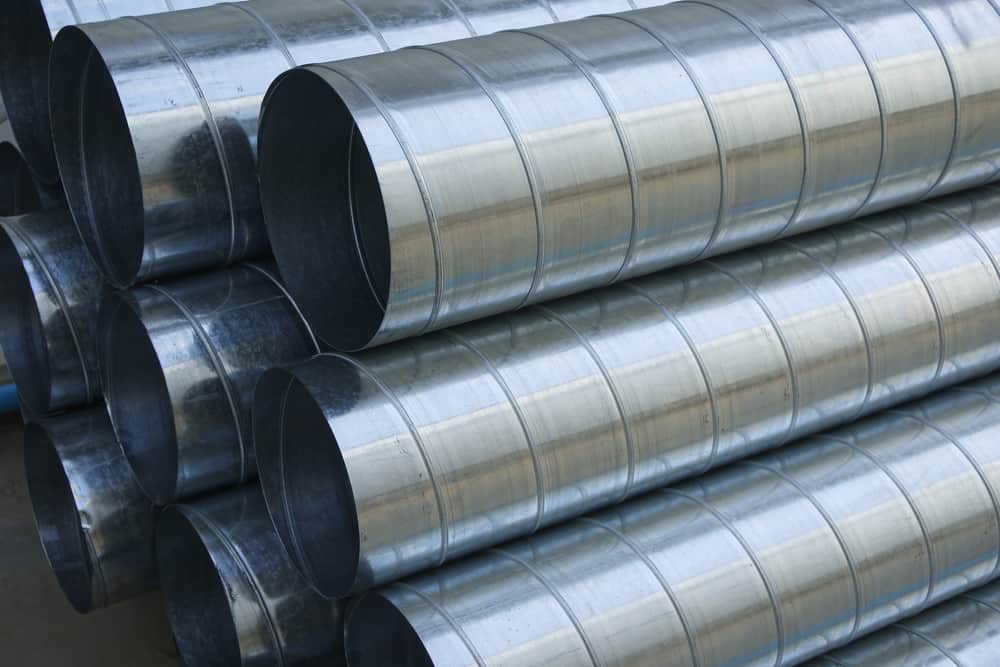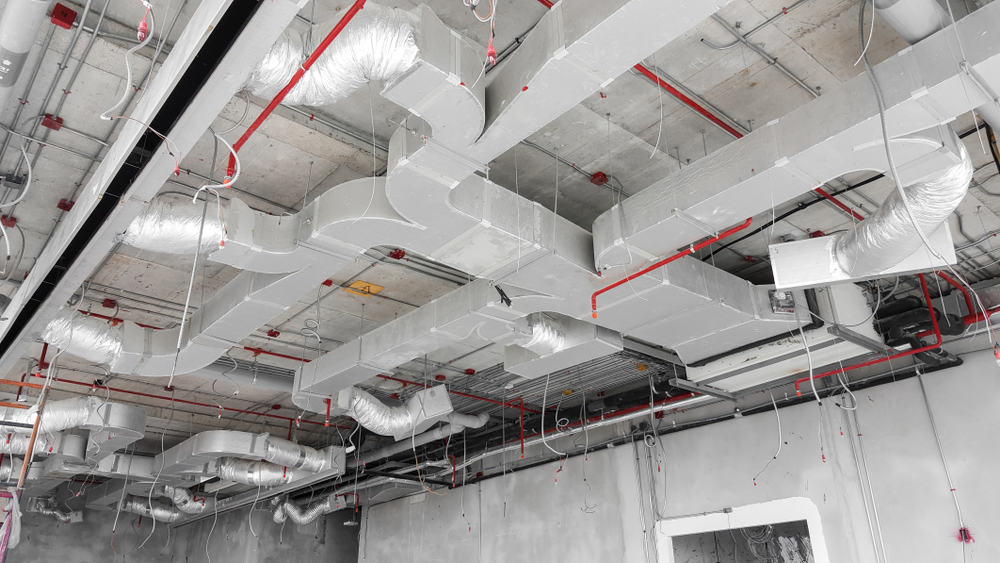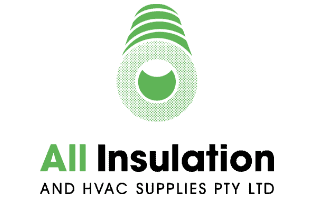Spiral Ducting
Spiral Ducting: A superior single or double-wall metal duct solution
Our spiral ducting is a cost-effective and easy-to-install ducting
system perfect for a range of commercial and industrial applications.
Lead Time
1 week or less
Specifications
Double Wall Spiral Ducting Insulation Fiberglass substrate insulation
25mm, 50mm, 75mm
What is Spiral Ducting?
Spiral Ducting is rigid metal ducting made from galvanised steel sheets. Spiral ducting is commonly used for heating and ventilation, air-conditioning, commercial kitchens, and dust and fume extraction. The spiral shape enables a smooth and robust airstream surface with almost no drag or resistance.
Galvanised steel is rust resistant making spiral ducting suitable for both indoor and outdoor applications. Spiral ducting is made from lightweight sheet metal which does not compromise strength but simplifies installation. Fewer horizontal and longitudinal joins results in less air leakage and also adds to the ease of installation. Spiral ducting is manufactured in long sections making it perfect for long pipe runs. The lightweight sheet metal is easy to cut and customise so is adaptable to most projects.
Insulating a single wall system requires lining spiral ducts with a wool or fibreglass duct liner or applying other insulation materials such as blanket-type insulation to the outer duct.
Double wall systems consist of galvanised sheet metal ducting with a layer of fiberglass substrate secured by a perforated metal lining. Insulated spiral ducting can increase the efficiency of any ventilation system thereby optimizing spiral duct performance.

Spiral Duct Systems Applications
Mechanical
Air Conditioning
Dust & Fume
Extraction
Dust and fume extraction systems are designed to move harmful dust and fumes from the point of production to a secure location where they can be neutralised or disposed of. The extraction fan creates airflow capable of capturing and transporting dust particles or fumes through a customised duct system. The efficiency of this system is dependent on maintaining constant and consistent airflow within the entire duct system. Effective dust and fume extraction are paramount to maintaining a compliant, safe, and healthy work environment. Choosing a spiral duct network optimises the extraction system and allows for long runs of pipework with almost no leakage of dust and fumes. The open tube results in minimal resistance and almost no drag, this means the extraction fan needs to do less work, and consume less energy, in order to keep harmful particles airborne. Designing and building an efficient ducting system is vital to ensuring extractions can be moved safely away from employees and customers.
Air Movement
Spiral ducting creates an air handling system with outstanding airflow properties. Open circular tubing with few joins allows air to travel through ductwork with minimal resistance. Optimised ventilation results in cleaner, healthier, more comfortable buildings, and workspaces. Limited joins when compared to rectangular ducting results in reduced leakage of air, dust, and fumes and improves overall system efficiency.
Residential &
Commercial Infrastructure
Ducted airflow improves the ventilation, and efficiency of buildings of all sizes, whether a small residential build or a large-scale commercial infrastructure. Insulated ducting improves building health and reduces energy consumption.
Spiral Ducting is a more aesthetically pleasing option than a rectangular duct. Modern design has seen both architects and HVAC system designers celebrate the infrastructure that sustains both industrial and corporate workspaces. In places where the duct systems remain exposed, the curved lines and fewer joins in spiral ducts imply softness and seamless flow unlike the hard edges of rectangular ducting systems.
Larger, often louder office environments benefit from the acoustic insulation provided by insulated duct systems. Spiral ducting is the perfect choice for buildings with specific noise control requirements. Acoustic insulation of spiral ducting systems is dual function. The insulated inner duct reduces the transmission of building noise to work areas making for quieter more productive environments and cross-talk noise entering the system via vents is absorbed by the duct liner instead of being carried between individual office spaces.
Civil & Industrial
Infrastructure
Spiral duct systems create better airflow for ventilation. Spiral duct performance can be optimised by including insulation which aids condensation control, as well as supporting energy efficiency and thermal and acoustic control. Insulated spiral ducting can be key to a high-performing HVAC system in both large-scale industrial infrastructure and civil construction.
Why Choose Spiral Ducting?
Customisable Spiral Duct Systems
HVAC system designers will specify duct sizes for each part of the ducting network, the duct size can positively or negatively impact the efficiency of entire system so it is important that duct size is carefully considered and is fit for purpose. We can supply specific duct diameters ranging from 100mm to 1000mm in diameter growing in 25mm increments and 1000mm – 1500mm diameters growing in 50mm increments. We offer single wall, or double wall (pre-insulated) spiral ducting to fit your purpose.
Unlike rectangular ducts, the flexible nature of spiral duct systems lets the metal duct wrap around obstacles creating HVAC pathways unique to each structure. Spiral ducting offers a simple solution to insulating straight runs of HVAC in large buildings. The flexible and adaptable quality of spiral ducting makes it the ideal solution for replacing or retrofitting a ducting system.
Thermal Control
Poorly insulated or uninsulated single wall ducting running through open spaces results in a heat differential between the air inside the duct and the air in the environment. This can result in significant heat loss or heat gain depending on the direction of the differential.
The temperature control system will need to work harder in order to compensate for the inefficiency, this results in increased running and maintenance costs and a reduction in equipment lifespan. Single wall systems in spaces that have high humidity or high dew point due to either the external environment or internal processes are susceptible to condensation build-up on the outside of ductwork. Condensation build-up can result in the breakdown of internal structures like plasterwork, or damage to machinery or infrastructure.
Poor thermal control and persistent moisture build-up sustain an environment ripe for hazardous bacteria and may create mold growth which can have negative health impacts for personnel and may be costly to eliminate. Choosing spiral ducting with a fiberglass substrate lining significantly reduces heat loss and heat gain and limits condensation thereby improving overall energy efficiency and consumption and reducing running costs.
Acoustical control
An HVAC ducting system typically connects individual office spaces via a network of pipes and vents, the downside of this is that it creates a conduit for sound to travel thereby creating louder office environments due to cross-talk noise carried throughout the system.
Workplace noise in schools, offices, hospitals, and other industrial and commercial premises has the potential to negatively impact the communication and productivity of employees. In extreme cases, excessive noise can have debilitating health effects. Compensation for negative health impacts and the cost of reduced productivity can have a significant effect on profitability margins.
HVAC systems by their nature create noise. Fans and mechanical systems create significant noise which can be carried and amplified by poorly insulated ducting. The air moving at high speed through the ducts creates its own unique sound that can be transferred to the surrounding environment. Noise from equipment and machinery located adjacent to ducting may be transferred directly through the duct wall and carried to other areas. Cross talk noise is the phenomenon by which voices travel from vent to vent by entering and exiting the airflow system via duct openings. This poses a significant risk to comfortability and privacy in most office spaces and corporate or commercial workplaces.
The spiral duct design optimises airflow by reducing resistance and limiting drag, this serves to offer acoustical control greater than that of a traditional rectangular duct. The insulation provided by double-walled spiral ducting absorbs fan noise and sounds created by air movement and delivery. As the inner duct pressure is equalised, better airflow is encouraged, this eliminates duct reverberation and dampens unwanted fan noise.
Cost Effective Duct System
Not only are spiral ducting systems a more effective and efficient solution, but it’s also significantly more cost-effective. Spiral ducting uses approximately one-third the amount of sheet metal required by regular ducting, and both manufacturing and installation require less sealing and fixing, this results in a cost reduction of up to 50%. Spiral ducting is simple and fast to install. Being lightweight, and having fewer joints reduces the labour required and speeds up overall build timelines meaning further savings can be made when compared to traditional rectangular ducting systems.
Optimizing spiral duct performance by choosing a double-wall system with an insulated inner duct, as opposed to a single wall system, enhances energy efficiency and reduces running costs by preventing heat loss and heat gain as the air heated or cooled by the conditioning unit moves through the ducting system. System designers choose double wall spiral duct systems as the complete and only solution for new builds. Lining spiral ducts with either a wool or fibreglass duct liner, after ducts have been fitted is costly and inefficient.
Simple Installation
A spiral duct system is generally easier to install than a traditional rectangular duct system which requires substantially more metal and more fixtures and fittings. Choosing a spiral ducting system lets the duct wrap around structures surrounding the system infrastructure without creating corners or joins, this makes installation a relatively simple process and enhances spiral duct performance. Ducting system designers choose spiral ducting for both new builds and for retrofitting established buildings. Spiral ducting systems can be especially useful during a retrofit where space and flexibility may be challenging.
Specially engineered spiral ducting fittings are used to join and extend pipe lengths to create a network of ducting tailored to the specific environment and infrastructure. Fittings are simple to use and intuitive to fit making spiral ducting installation relatively easy.
Double wall systems require less time and manpower to install as they are preinsulated therefore the installation process does not require the addition of either an inner duct liner or outer blanket type insulation.
Lining single wall systems is less common than choosing double wall spiral duct systems from the outset. Lining spiral ducts requires significantly more labour and can prove more costly.
Your New Insulation Supplier
Our team is passionate about continuous innovation and improvement. It starts with the constant development of our insulation products and is carried through by the service we provide you with.
As your trusted insulation supplier, we work hard to promise you shorter lead times so you can position yourself as a reliable insulation installer.
Need the installation too? Get in touch with our friendly team.



